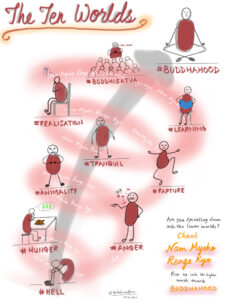
The Ten Worlds are not physical locations but states of life that coexist within each individual. They fluctuate based on one’s internal mindset and external circumstances, emphasizing the fluidity of human experience. Let’s delve into each world:
- Hell
The world of Hell is characterized by intense suffering, despair, and hopelessness. In this state, individuals feel consumed by their pain, believing there is no escape from their misery. Hell is marked by a sense of powerlessness and can result in destructive behavior toward oneself or others. - Hunger
Hunger represents an insatiable craving or longing, driven by desire and greed. Those in this state constantly seek satisfaction from external sources, whether material possessions, status, or relationships, yet remain perpetually unfulfilled. This condition creates a cycle of dissatisfaction and yearning. - Anger
Anger is a life state driven by competitiveness, jealousy, and a desire to dominate others. Individuals in this state are often consumed by their ego, reacting aggressively to perceived slights or challenges. While it can manifest as ambition or determination, anger lacks the compassion necessary for lasting harmony. - Animality
The world of Animality reflects instinct-driven behavior, focusing on survival and immediate gratification. In this state, individuals may act without consideration for others, guided by fear or opportunism. Relationships are often transactional, based on power dynamics rather than mutual respect. - Rapture
Rapture, also referred to as Heaven, is a state of temporary happiness or joy resulting from the fulfillment of desires. While uplifting, this state is fleeting and dependent on external circumstances. A shift in fortune can quickly dissolve the sense of euphoria, leading to instability. - Tranquil
Tranquil, also known as Humanity, is a calm and balanced state where individuals can reason and coexist peacefully with others. It represents the foundation for higher life states, yet it is inherently unstable. Without effort, one can easily fall into lower worlds such as Anger or Hunger. - Learning
In the world of Learning, individuals seek self-improvement and enlightenment through studying the teachings of others. They cultivate awareness and gain knowledge to better understand themselves and the world around them. However, if not paired with action, this state can remain intellectual rather than transformative. - Realization
Realization involves gaining profound insight into the nature of life through personal observation and experience. It reflects a deeper understanding of interdependence and impermanence. However, like Learning, it can become self-centered if not accompanied by compassion for others. - Bodhisattva
The Bodhisattva world is marked by altruism and a commitment to the happiness of others. Individuals in this state prioritize helping others achieve enlightenment, often placing their own needs secondary. This state embodies compassion and a sense of interconnectedness with all life. - Buddhahood
Buddhahood is the ultimate state of enlightenment, characterized by boundless wisdom, compassion, and inner peace. In this state, individuals are unaffected by external circumstances, experiencing a profound joy that transcends suffering. It represents the realization of one’s inherent dignity and the interconnectedness of all life.
Mutual Possession of the Ten Worlds
A key teaching in Nichiren Buddhism is the principle of “mutual possession of the Ten Worlds.” This means that each world contains aspects of the other nine. For example, even in the depths of Hell, the potential for Buddhahood exists, and within Buddhahood, there remains an awareness of the struggles experienced in lower states.
This interconnectedness underscores the transformative potential within every individual. It teaches that no one is permanently bound to a particular life state and that enlightenment is always within reach.
Practical Application in Daily Life
The Ten Worlds are not merely philosophical concepts but practical tools for self-awareness and growth. They help individuals recognize their current state of life and provide insight into how to elevate it. For example, understanding that one is in the state of Anger or Hunger can inspire reflection and action to cultivate higher states such as Tranquil or Bodhisattva.
Through the practice of chanting Nam-myoho-renge-kyo, practitioners can activate their inherent Buddha nature, transforming lower life states into positive and empowering ones. This practice enables individuals to navigate life’s challenges with wisdom and compassion, fostering both personal and societal harmony.
Relevance in Modern Times
In a fast-paced and complex world, the Ten Worlds offer a valuable framework for understanding human behavior and relationships. They encourage self-reflection, resilience, and empathy, reminding individuals that their state of life significantly impacts their environment. By striving toward Buddhahood, practitioners not only elevate their own lives but also contribute to the happiness and well-being of others.
Conclusion
The Ten Worlds in Nichiren Buddhism present a powerful model for understanding the human condition and the potential for transformation. By recognizing and addressing the life states within oneself, individuals can cultivate wisdom, compassion, and unshakable happiness. This teaching serves as a timeless reminder that enlightenment is not a distant ideal but a reality accessible to everyone through faith, practice, and study.
